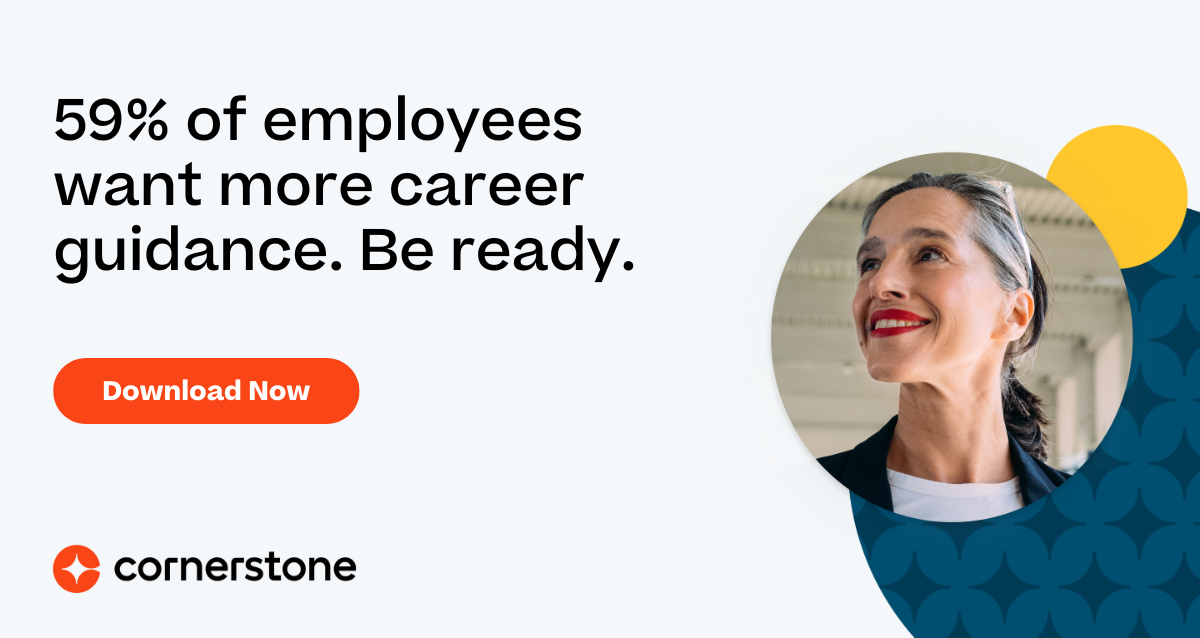Key Takeaways
- Flexible work models and hybrid solutions will continue shaping the future of work.
- HR will focus more on employee well-being and mental health in 2024.
- Technology adoption will drive greater agility and personalized talent development strategies.
At the crossroads of technology and the workforce, HR leaders boldly lead the charge in transforming how organisations navigate today's complex world of work. As we enter 2024, the rapid pace of change, fuelled by technological advancements, demands a keen understanding of emerging trends.
The new Cornerstone eBook, Remaking Work for a New World: 2024 HR Predictions, serves as a compass, guiding organisations through this intricate web of change. From AI-powered personalisation to the ascent of skills as the new currency, our exploration delves into the realms of culture, technology, skills strategy, learning and development, content strategy, performance management, talent mobility and data analytics.

In this blog post, we'll unravel the trends shaping the future of work and uncover actionable revelations, drawing insights from industry experts, the Talent Health Index and Cornerstone's thought leaders, to empower HR managers in steering their organisations toward success.
As we cast our gaze back to 2023, HR witnessed an intricate interplay of forces, propelling talent management into uncharted territories. From the omnipresence of AI transforming learning landscapes to the seismic shift towards skills-focused job architectures, the corridors of HR echoed with change.
Noteworthy developments included the maturation of hybrid work practices, a paradigm shift in recruitment towards skills-centric approaches and a concerning reduction in investments in diversity, equity, inclusion and belonging (DEIB) initiatives. Our inaugural Talent Health Index uncovered critical insights, revealing the pulse of the industry.
As we move forward, these reflections set the stage for anticipating and proactively addressing the evolving needs of the workforce. The journey into 2024 demands a strategic alignment with the transformations witnessed in the preceding year.
The Cornerstone Talent Health Index provides a comprehensive snapshot of the current state of talent management. With findings revealing employee concerns about skills development, a lack of AI technology utilisation and substantial demand for career guidance, the report serves as a valuable compass for HR leaders navigating the evolving landscape.
Key findings from the Talent Health Index resonate with the challenges and opportunities ahead:
- Skills development gap: 41% of employees expressed a lack of resources for skill developmen
- AI uptake: Over 60% of organisations underutilised AI in optimising talent programs
- Career guidance demand: 59% of employees sought more guidance in their career
These revelations guide organisations toward the imperative need for adaptive strategies in the swiftly evolving HR landscape. The coming year beckons a proactive embrace of these insights, laying the groundwork for a workforce poised for growth, resilience and success.

To gain deeper insights, let's turn to the voices of industry experts who offer unique perspectives on the evolving workplace.
- VP of Group Talent Acquisition Learning and Growth at DHL Group Meredith Wellard – "Well-managed AI is no more biased than the data that feeds it in the first place, which comes from the humans who’ve been working on it. So let’s stop operating in fear and take the opportunity to minimise that bias. Let’s talk about how we can ensure that we all understand what trains our AI, that we all have our heads around which tools we can use that are risk-free and that we have a quality control process afterward.”
- Director of Global Learning Learning Technologies and Content Development at Encore Chad Otto – "I can see talent strategy evolving because of AI in two ways. One: I think it’s going to be easier to map skills and map them to content. Two: You can do role-playing with AI to assist people in their learning. I think the ability to make that more available to more people is really going to change the landscape.”
- Chief Executive Officer at Cornerstone Himanshu Palsule – "For organisations to truly thrive in 2024 and beyond, learning must be personalised and accessible, and technology must be responsible, intuitive and intelligent. Most importantly, learning strategies must stay at pace with the changing needs of the workforce. It is only then that you will bear witness to the power of a truly holistic learning and talent experience.”

Various dimensions collectively contribute to the overall well-being of a talent program:
1) Culture & Technology
In the realm of Culture & Technology, the Chief Product Officer at Cornerstone Karthik Suri advocates for just-in-time learning. The intersection of organisational and individual needs is crucial, where AI-powered personalisation becomes critical to streamlining talent processes and fostering a culture of diversity and inclusion.
2) Skills Strategy
Skills-based recruitment takes centre stage, and organisations must identify skills gaps through shared skills language. GVP of Strategic Initiatives at Cornerstone Mike Bollinger envisions skills-based succession planning as integral to effective workforce planning.
3) Learning & Development
2024 will witness the extensive use of AI in mapping existing skills to content and creating personalised learning experiences. Chief Learning Officer at Cornerstone Marc Ramos sees AI as a catalyst for efficiency in content creation and gaining insights into learning analytics.
4) Content Strategy
Content becomes a linchpin for learning and development, directly tied to business challenges. User-generated content integration and a focus on accessible learning for people with disabilities emerge as strategic imperatives.
5) Performance Management
Performance management undergoes a paradigm shift with the widespread adoption of Objectives and Key Results (OKRs). Director of Strategy Services at Cornerstone Cheryl Paxton-Hughes envisions ongoing performance conversations replacing traditional annual reviews, putting employees in the driver's seat of their development.
6) Talent Mobility
Internal recruiting gains prominence as organisations prioritise transparency in open positions and encourage employees to explore career opportunities. Talent mobility becomes a key focus, fostering a culture of shared talent and internal collaboration.
7) Talent Reporting, Data & Analytics
Proactive data approaches, centralised reports, and visual dashboards are essential for mature organisations. When used strategically the Chief Research Officer at Sapient Insights Group Stacey Harris underscores the transformative power of HR and talent analytics.

As organisations gear up for 2024, seven key predictions emerge:
- AI will power more personalised learning – Integrating AI will revolutionise learning experiences, making them more tailored and effective.
- Companies will prioritise skills over experience – A paradigm shift in hiring approaches, focusing on skills as a primary criterion.
- Companies will transform into skills marketplaces – Organisations will evolve into dynamic environments where skills are actively developed and traded.
- Content will tie more directly to business challenges – Learning content will be closely aligned with real-world business needs.
- Ongoing conversations will replace annual reviews – Performance management shifts towards continuous, employee-driven discussions.
- Talent sharing will grow – Internal talent mobility becomes a strategic focus for organisations.
- Real-time analytics will improve results – Data-driven decision-making gains prominence with real-time analytics.
Navigating the future of work
In 2024, HR stands at the crossroads of transformative change. Cornerstone's predictions for the year provide a strategic blueprint for organisations to adapt and thrive amid unprecedented shifts. The central directive is clear: invest in your people.
Bernd Leger, Chief Marketing Officer at Cornerstone, underscores the importance of intuitive technology as a co-pilot, working symbiotically with employees to navigate the evolving career landscape. This rapid change presents an unparalleled opportunity for businesses to invest in learning, fostering growth and innovation.
As we embark on this journey, the key lies in continuous learning, strategic talent management and cultivating a culture of growth. The evolution of HR is not just a response to change but a proactive stance, leading us into an era where organisations and their people flourish in tandem. With the right skills, knowledge and technology, the challenges of the future become opportunities for success.
Discover the future of work by downloading the new Cornerstone eBook, Remaking Work for a New World: 2024 HR Predictions, here.
Take our 10-minute talent health assessment, providing immediate next steps for optimising talent programs and accelerating talent ROI.


